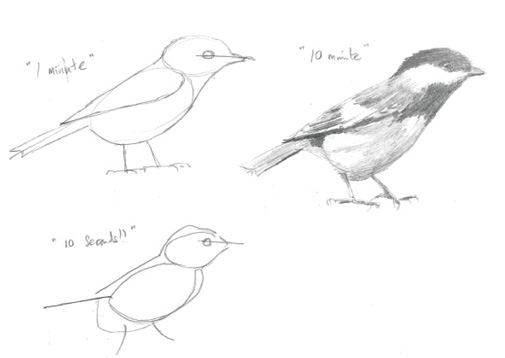
Speed sketching exercise. Image courtesy of Tony Abbey.
Latest News
October 1, 2019
Editor’s Note: Tony Abbey teaches both live and e-learning classes for NAFEMS. He provides FEA consulting and mentoring. Contact tony@fetraining.com for details.
Have you seen the LinkedIn video where an artist draws an image in 10 minutes, then attempts the same drawing in 1 minute and then in 10 seconds? The video has been posted many times over the past few years.

The full image is professional and polished, as expected. The 1-minute effort produces a simple outline of the original. The 10-second attempt is frenetic and produces an unfinished and highly distorted scribble.
The post accompanying the video makes the point that artificially imposing an unrealistic timescale on a job will result in a very poor performance. I fully understand the analogy—if you want a finite element analysis job done well, then allocate adequate resources.
Normally I just nod to myself and don’t bother to respond to the post. However, this time the video struck a chord and I did comment and got a lot of feedback!
I had just watched a video on YouTube that aimed to teach how to sketch birds accurately. One of my hobbies is sketching and I wanted to improve on my attempts. Check out the video if you are interested.
Laws encourages the class to do exactly what the LinkedIn video criticizes. By doing a speed sketch, following a structured approach, the artist is not overloaded with clutter. The speed sketch should, ironically, take about a minute. The form and shape of the bird can be laid down very quickly with confidence. It forms a foundation for the fully worked up drawing. I spent a couple of hours doing this exercise and it really improved my skills. (You can see my attempts in the image on this page.)
The Need for Speed
I thought further about the LinkedIn video analogy. Perhaps the analogy should be: for the fully completed and reviewed project, fully documented, 10 minutes. For a broad overview of project feasibility and methodology, 1 minute. The times here are relative for an engineering project, not real time.
The speed sketch is now analogous to a brainstorming session, where you alone, or as part of a team, distill the essentials of the project task. You don’t want to go into details—and it may take a lot of self-discipline or team management to avoid all those tempting “rabbit holes.”
I posted my comment about speed sketching, and I was surprised how it seemed to resonate. One reply discussed speed modeling in CAD as another analogy to speed sketching. The idea here is that if you are experienced, then you know how to rapidly lay out an assembly or part using shortcuts. This was interesting to me, as I struggle to create CAD assemblies efficiently and usually get bogged down in part detail.
Others made the point that the artist in the video is very experienced and he is transferring knowledge between the three time-based tasks. So, it is clear that an inexperienced newcomer to CAE, for example, will not be able to provide any meaningful input with the 1-minute analogy.
My premise is that the 1-minute rapid sketch is useful in the right context, which is to produce a structured outline for planning and foundational work. If a client expects the full 10-minute result instead—tell them about the drawing analogy.
I do agree 10 seconds is not going to produce much, even for a skilled artist. The only analogy I can think of here is the elevator speech, which aims to get the essential message over very fast. But it also means you are fully experienced in the 10-minute and 1-minute stages, so you know what you are talking about.
Subscribe to our FREE magazine, FREE email newsletters or both!
Latest News
About the Author
Tony Abbey is a consultant analyst with his own company, FETraining. He also works as training manager for NAFEMS, responsible for developing and implementing training classes, including e-learning classes. Send e-mail about this article to DE-Editors@digitaleng.news.
Follow DE





